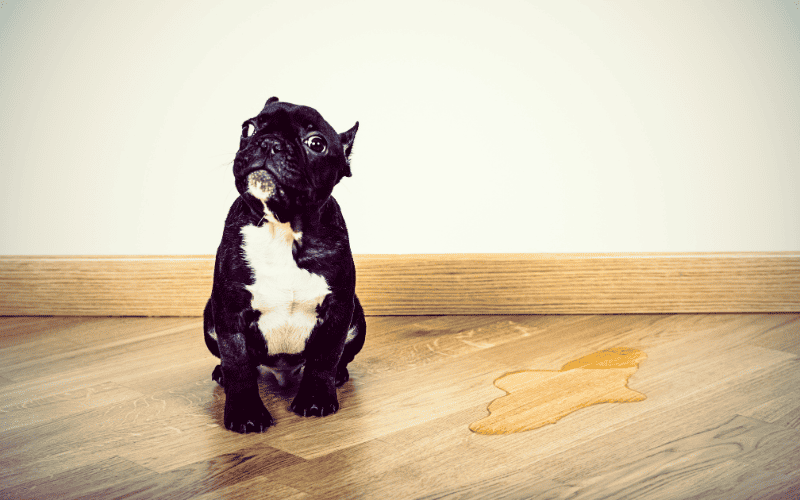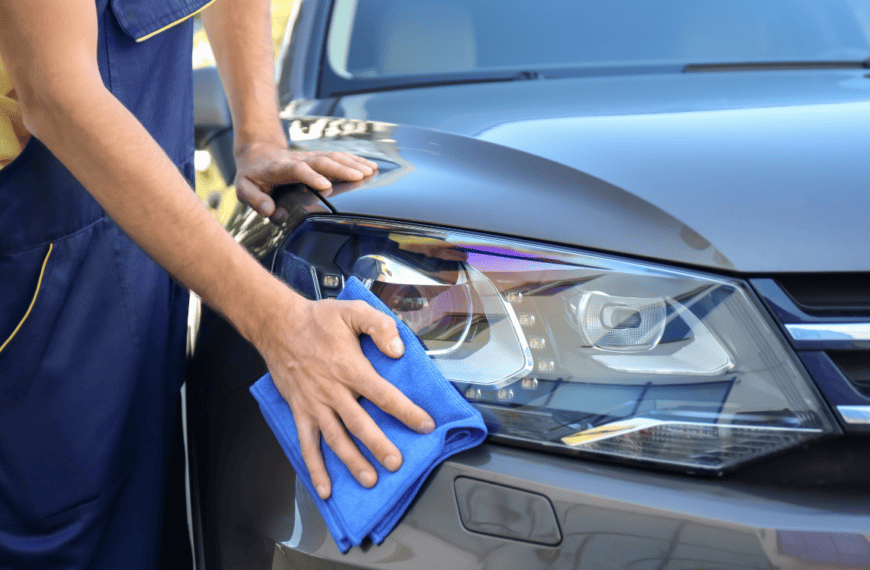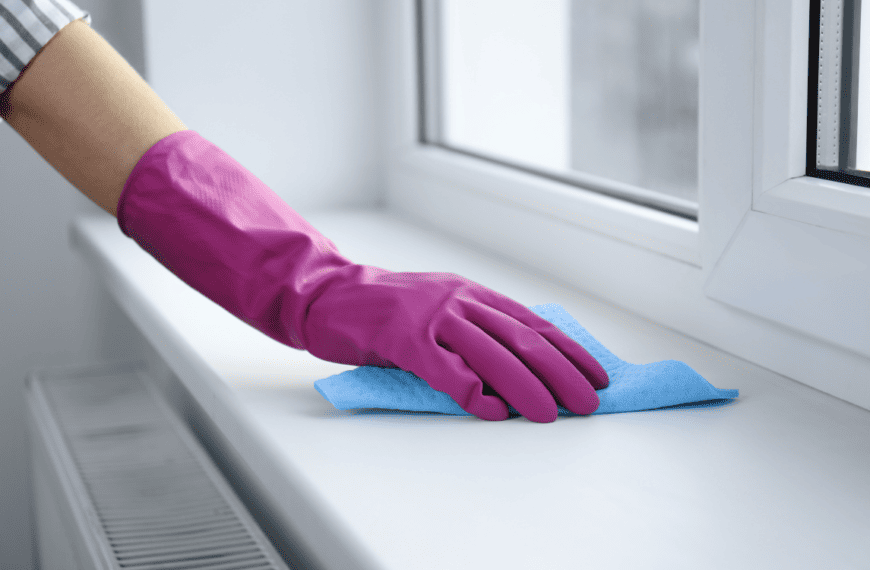Attractive, durable, and easy to maintain, classic hardwood is the preferred flooring option for two-thirds of American homeowners. Beyond being practical, a pristine wood floor is a source of pride, one we’re excited to showcase wherever we can. If only our pets showed the same appreciation!
It may be tough, but hardwood isn’t impervious to claws and pet stains. If urine soaks through a rug or stays hidden behind furniture, you’ll be heartbroken to find ugly, ingrained black stains and foul odors ruining your flooring.
Set-in black urine stains look impossible and, if we’re being honest, often require extensive repairs. But in certain circumstances, you can make even months-old urine disappear with patient effort and clever cleaners. And fortunately, the best solutions are often household staples!
If you’re ready to refresh your space, I’ll explain how to remove old black urine stains from hardwood floors as efficiently as possible.
Why Is There a Black Urine Stain On Your Hardwood?
Dog and cat urine stains can be highly acidic. As uric acid crystals damage hardwood through prolonged contact, they’ll eventually turn the area black. Most hardwood floors have protective coatings to slow wear and prevent moisture penetration. After a few hours, the urine stain can degrade the finish and begin causing irreparable damage to the underlying wood.
Uric acid and its byproducts interact with tannins in the wood to burn in a dark coloration. Some species, such as oak and walnut, have a higher tannin concentration, causing them to stain faster and more aggressively.
Removing black urine stains isn’t easy. As the pet urine binds with and changes the hardwood’s composition, it permanently alters the color. You can’t easily apply a cleaning solution and remove a surface-level stain to reveal clean wood underneath. There are also foul urine odors to handle, creating another often-unrelenting cleaning challenge.
How to Remove Black Urine Stains from Hardwood Floors
Hydrogen peroxide is the best option to eliminate black urine stains. It’s inexpensive, readily available, and safe to use, but most importantly, its bleaching capabilities are exceptional at pulling out tough stains. If peroxide doesn’t work, sanding and refinishing or complete board replacement will be your only option.
The common eventuality of having to refinish to remove black urine stains from hardwood is a situation most of us would love to avoid. Early action is critical to keep your cleaning technique simple. If you can remove pet urine stains within 1–2 hours of them happening, the protective coating will keep most, if not all, of the urine from making a lasting impact.
I’ll break down our top tips to prevent a damaging stain and cleaning process to restore your flooring. We’ll start with the easy methods and end with the most effective. Depending on the severity of the floor stains, you could get by with mild solutions and a quick scrub, or you may want to skip straight to the most effective yet more time-consuming options.
Tip #1: Vinegar and Essential Oil
Although it isn’t as lasting or effective as an enzyme cleaner, vinegar is a popular option for many trying to remove cat odors from household materials. It’s easy to use and likely on hand in your house right now, so it’s worth a shot if you have to clean black urine stains that haven’t had enough time to sink into the wood surface.
Many people advise using grapefruit oil because of its natural disinfectant traits and citrusy aroma, but I don’t think you should worry if you don’t have that exact essential oil. Numerous options, like lemon or cinnamon oil, boast similar antiseptic benefits while covering vinegar’s pungent odor with a more pleasant scent. It may not remove cat urine stains that have had a chance to set, but a vinegar cleaner can often help prevent re-marking.
Tools and Materials
- Distilled white vinegar
- Essential oil
- Spray bottle
- Stiff brush
- Clean cloth
How to Remove Black Urine Stains with Vinegar
- Mix a cup of white vinegar with four cups of water and a few drops of essential oil in a spray bottle
- Spray the stain
- Scrub the cleaner into the stain with a stiff brush
- Dry with a clean cloth
| Pros | Cons |
| 1. Easy to use and non-toxic 2. Essential oils mask the scent and disinfect 3. Can help prevent repeat accidents | 1. Only practical on fresh urine stains |
Tip #2: Baking Soda
Baking soda is one of the most versatile DIY cleaners in the home and an excellent supplement to other cleaning solutions on this list. It’s a safe and simple way to absorb fresh urine and neutralize any recurring acidic foul odor. I’ve provided a method for using it as a standalone option to clean urine stains. To improve its effectiveness, combine it in a paste with hydrogen peroxide or use it as a follow-up to a vinegar treatment.
Tools and Materials
- Baking soda
- Clean cloth
- Water
- Stiff brush or fine-grade steel wool
Removing Black Urine Stains with Baking Soda
- Mix baking soda with warm water to form a thick paste
- Rub the paste into the stained areas of your hardwood floor with a brush or steel wool
- Let the paste sit for at least one hour
- Sweep or vacuum the paste, and clean the remaining residue with a clean, damp cloth
| Pros | Cons |
| 1. Easy to use and non-toxic 2. Inexpensive and easy to find 3. Neutralizes foul odors 4. Absorbs moisture | 1. Ineffective on deep stains |
Tip #3: Enzyme Cleaner
Enzyme cleaners are great for pet stains in dog beds, carpets, clothing, and nearly any other absorbent material in the home. Although they’re only effective on fresh stains on hardwood floors, they’re one of the most thorough and safest options for organic marks and pet odors.
If your pet constantly pees in the same spots, enzyme cleaners will remove any trace of urine or odor compounds that could draw them back to the scene for repeat messes. The natural enzymes in products like ECOS Pet Stain & Odor Remover break down and remove uric acid and other organic compounds, cleaning the stain until they consume every bit of urine.
Follow the product directions for use, noting the appropriate dwell time for hardwood floors. Persistent stains may require the cleaner to sit longer or take repeated applications to disappear entirely.
| Pros | Cons |
| 1. Easy and safe to use 2. Naturally eliminates odors and urine compounds 3. No cleanup required | 1. Won’t remove set-in black urine stains |
Tip #4: Commercial Products
Alongside commercial pet stain removers, you can try hardwood floor cleaners like Bona or Rejuvenate for safe dirt and grime removal. Solutions like these are generally only effective for surface-level stains and may not remove deeply absorbed urine. But they’re an ideal general-purpose cleaner, one you should keep on hand for regular hardwood floor cleaning whether or not you have an issue with pets leaving black urine stains.
| Pros | Cons |
| 1. Shines and refreshes wood floor 2. Easy and safe to use | 1. Not effective for tough urine stains |
Tip #5: Oxalic Acid
Wood bleach, or oxalic acid, is an ideal cleaning solution to remove black urine stains that have had time to soak into and damage your wood floor. The powdery cleaner is highly corrosive and hazardous without adequate safety precautions. Wear rubber gloves during use, and take extra steps to prevent accidental inhalation or ingestion.
How to Remove Old Black Urine Stains with Wood Bleach
Follow the manufacturer’s directions to mix the proper ratio of wood bleach with hot water. You will have to remove any protective sealant or top coat to affect the color of the black wood.
Scrub the solution into the stain with a stiff brush, and let it dry. It won’t take much elbow grease, but removing stubborn black urine stains with wood bleach can take dozens of applications and several days.
To neutralize the lingering acid in the floor, you’ll need to rinse with a mild alkaline cleaner like borax or baking soda mixed in water. In most instances, you will also have to sand and stain afterward to create a seamless surface, which could be more challenging than simply refinishing the stained area.
| Pros | Cons |
| 1. Effective against deep hardwood floor stains 2. Maintains wood composition | 1. Takes a long time to work |
Tip #6: Hydrogen Peroxide
Hydrogen peroxide is the tried-and-true DIY method to clean tough urine stains from hardwood floors. Although it takes a long time to work on the worst messes, hydrogen peroxide is safe and highly effective in bleaching wood and restoring the grain to a manageable state. As with oxalic acid, you’ll get the best results by stripping back any protective finish from your hardwood floor before using the cleaning solution.
The standard 3% hydrogen peroxide in your medicine cabinet can work, though you can expect a time-consuming cleaning process. Using a more powerful version like 12% hydrogen peroxide or 40 Volume, you should see faster, more satisfying results.
Tools and Materials
- Hydrogen peroxide
- Paper towels
- Clear plastic wrap (optional)
How to Clean Black Urine Stains with Hydrogen Peroxide
- After stripping back the finish, cover the urine-stained area with paper towels
- Saturate the paper towels with hydrogen peroxide
- Let the peroxide sit for several hours or overnight (cover with plastic wrap, if desired, to slow evaporation)
- Check for progress, and repeat as necessary until the stains lighten
| Pros | Cons |
| 1. Effective on tough black urine stains 2. Easy and safe to use | 1. Can take several days to work |
Tip #7: Sand and Stain
When push comes to shove, you may have to sand and stain your floor to remove black urine stains in their entirety. Check out the video below first to see if you feel confident tackling the project or would rather pay a professional. Renting the equipment and acquiring the tools for a day project will run roughly $200–$300. For a professional, you’ll likely pay at least twice that amount.
Hide Black Urine Blemishes with a Dark Floor Stain
If you sand several layers and find the black urine isn’t going away, you may be able to hide it. Consider using a dark-colored stain for your floors, like an espresso or charcoal. You’ll usually have to redo the entire floor if you want the smoothest possible finish anyways, so you won’t be wasting any time by changing the color. With a darker tone concealing any leftover stains, you’ll have an elegant fix to revitalize the room and save you from a full-blown replacement.
| Pros | Cons |
| 1. Avoids floorboard replacement 2. Effectively removes tough black urine stains | 1. ExpensiveLabor-intensive 2. More challenging for DIYer |
Tip #8: Replace Floorboards
When black urine stains go extra-deep, sanding won’t be sufficient unless you’re okay with glaring dips in the floor. Thankfully, pets sometimes make the job easy, like when you have black cat urine stains along wall edges from spraying. Replacing floorboards is never convenient, but it’s much easier when the damage is near the edge of the floor where it meets the wall.
Replacing Hardwood Floors to Eliminate Black Urine Stains
Removing floorboards involves using a circular saw and hammer/crowbar to cut out the stained sections. Having spare floorboards handy is essential to replace the damaged pieces and help you measure the proper cut depth for your blade. Depending on your situation and preference, you can fix the new boards in place with adhesive or a nail concealed under wood putty. Below is a brief video explaining one way to complete the job.
Note: If the discoloration runs through the floor, consider using an enzyme cleaner on the subfloor before replacing the board. A deep stain could create a faint odor, which may be enough to lure your dog or cat back for another round of inappropriate urination. You can prevent recurring cleaning jobs by using an enzyme cleaner to remove every trace before reinstalling the boards.
| Pros | Cons |
| 1. Completely removes deep black urine stains 2. Preserves floor finish and original look | 1. Labor-intensive 2. More challenging for novice DIYer |
How Can I Prevent My Pet From Urinating on the Hardwood Floors in the Future?
After seeing what it takes to get rid of your first black urine stain, you’ll want to do everything you can to avoid dealing with that job ever again. While you can’t 100% guarantee that your cat or dog won’t have an accident in the house, you can reduce the likelihood of pet urine stains becoming a cleaning nightmare. Here are a few tips to help you limit the risk of black urine stains on your hardwood floors:
- Uncover the root problem. Inappropriate urination on hardwood floors is typically due to stress, health issues, or poor training. Consider what changes may influence the behavior and how you can affect it. Try to keep their daily routine consistent to encourage positive habits.
- Crate train your dog. Crate training your dog can help you control where they go to the potty and easily teach solid bathroom habits at a young age. Set up the crate in a room with hard tile or linoleum flooring to make cleanups easy.
- Regular vet visits. Your vet can give you tailored advice for dealing with inappropriate elimination. Frequent screenings can also identify potential health problems that may cause the issue.
- Use absorbent materials under litter boxes. Black urine stains are common under litter boxes, an easily preventable problem with a cat mat or towel.
- Use a high-quality sealant. A durable hardwood finish will keep urine from penetrating the wood, preventing black stains and making cleanups fuss-free.
- Clean regularly. Growing pee stains often hide under area rugs and behind furniture pieces. With a consistent cleaning schedule, you can identify and handle the issue early.
How Often Should I Apply Sealants or Oils to Protect My Hardwood Floors?
Sealants need regular replacement as everyday foot traffic and abuse take their toll. The frequency will depend partly on the product, with some needing annual replacement and others needing a refresh every 3–5 years. The highest-quality professional finishes can last several decades.









